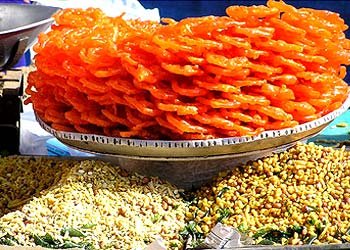
1. palak ki puri :

Palak puri is made by mixing wheat flour with pureed spinach and other spices. It is best enjoyed hot with mango chutney and chili pickle. Spinach puri served with potato curry makes a good lunchbox recipe. Learn how to make palak poori by following this easy recipe.
2. Halva :

Halva (halawa, alva, haleweh, halava, helava, helva, halwa, halua, aluva, chalva) refers to many types of dense, sweet confections, served across the Middle East, South Asia, Central Asia, West Asia, North Africa, the Horn of Africa, the Balkans, Central Europe, Eastern Europe, Malta and the Jewish world.
3. Kebab :

Kebab (also kebap or kabab) is a Middle Eastern dish of pieces of meat, fish, or vegetables roasted or grilled on a skewer or spit originating in the Middle East, and later adopted in Central Asia and by the regions of the former Mongol Empire and later Ottoman Empire, before spreading worldwide. In American English, kebab with no qualification refers to shish kebab (Turkish: ?i? kebap) cooked on a skewer, whereas in Europe it refers to doner kebab, sliced meat served in a pita. In the Middle East, however, kebab refers to meat that is cooked over or next to flames; large or small cuts of meat, or even ground meat; it may be served on plates, in sandwiches, or in bowls. The traditional meat for kebab is lamb, but depending on local tastes and religious prohibitions, other meats may include beef, goat, chicken, pork or fish. Like other ethnic foods brought by travellers, the kebab has remained a part of everyday cuisine in most of the Eastern Mediterranean and South Asia. It is also popular among Western youth as a snack after a nightout.
4. Shami kebab :

hami kebab or Shaami kebab is a popular local variety of kebab especially in Punjab. It is a part of Indian and Pakistani cuisine. A variation of the Shaami kebab is also found in Bangladeshi cuisine. It is composed of a small patty of minced meat, (usually beef or mutton in India, but occasionally lamb or mutton), with ground chickpeas, egg to hold it together, and spices.Shami kebabs are a popular snack throughout India and Pakistan. They are often garnished with lemon juice and/or sliced raw onions, and may be eaten with chutney made from mint or coriander. They are also served along with Sheer Khurma during Eid celebrations.
5. Raita :

Raita is an Indian, Pakistani and Bangladeshi condiment made with yogurt (dahi) and can be used as either a sauce or dip, or a salad. The yogurt may be seasoned with coriander, cumin, mint, cayenne pepper, and other herbs and spices.
6. Jalebi :

Jalebi is a sweet popular in countries of the Indian Subcontinent such as India, Bangladesh, Nepal, Pakistan and Sri Lanka, and in many countries in the Middle East and North Africa, like Iran, Iraq, Jordan, Syria, Palestine, Lebanon, Egypt, Tunisia and Algeria. As well as several East African countries such as Zanzibar, Comoros and Mayotte. It is made by deepfrying a wheat flour (maida flour) batter in pretzel or circular shapes, which are then soaked in sugar syrup. They are particularly popular in the subcontinent during Ramadan and Diwali.The sweets are served warm or cold. They have a somewhat chewy texture with a crystallized sugary exterior coating. Citric acid or lime juice is sometimes added to the syrup, as well as rose water or other flavours, such as kewra water.
7. Chaat :

Chaat is a term describing savory snacks, typically served at roadside tracks from stalls or food carts in India, Pakistan, Nepal and Bangladesh. With its origins in Uttar Pradesh, chaat has become immensely popular in the rest of South Asia. The word derives from Hindi c?? (tasting, a delicacy), from c??n? (to lick), from Prakrit ca??ei (to devour with relish, eat noisily).

